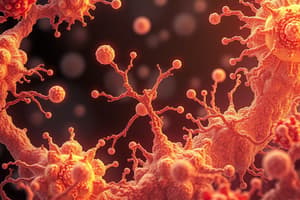Podcast
Questions and Answers
Which type of epithelial tissue is characterized by a single layer of flat cells?
Which type of epithelial tissue is characterized by a single layer of flat cells?
- Simple Squamous (correct)
- Stratified Cuboidal
- Simple Cuboidal
- Simple Columnar
Identify the type of epithelial tissue that lines the trachea and bronchi.
Identify the type of epithelial tissue that lines the trachea and bronchi.
- Stratified Squamous Epithelium
- Simple Columnar Epithelium
- Simple Squamous Epithelium
- Pseudostratified Ciliated Columnar Epithelium (correct)
Which type of epithelial tissue primarily functions in secretion and is found in glands and ducts?
Which type of epithelial tissue primarily functions in secretion and is found in glands and ducts?
- Simple Columnar
- Simple Cuboidal (correct)
- Simple Squamous
- Stratified Cuboidal
What describes Stratified Cuboidal Epithelium?
What describes Stratified Cuboidal Epithelium?
What is the primary function of Simple Columnar Epithelium?
What is the primary function of Simple Columnar Epithelium?
Identify the epithelial tissue with a structure of one layer of cells with varying heights and cilia.
Identify the epithelial tissue with a structure of one layer of cells with varying heights and cilia.
Which epithelial tissue type is best suited for areas requiring stretch and recovery?
Which epithelial tissue type is best suited for areas requiring stretch and recovery?
What type of cell junction is formed by connexins?
What type of cell junction is formed by connexins?
What type of epithelial tissue lines the upper esophagus?
What type of epithelial tissue lines the upper esophagus?
What is an example of a tissue composed of tightly packed cells without a free surface?
What is an example of a tissue composed of tightly packed cells without a free surface?
Which type of epithelium is primarily found in areas subject to stretching, such as the bladder?
Which type of epithelium is primarily found in areas subject to stretching, such as the bladder?
Which epithelial tissue type is primarily involved in absorption and secretion in glandular areas?
Which epithelial tissue type is primarily involved in absorption and secretion in glandular areas?
Which type of epithelial tissue is characterized by a single layer of cells with differing heights?
Which type of epithelial tissue is characterized by a single layer of cells with differing heights?
Which type of epithelial tissue is involved in protecting underlying tissues in areas subject to abrasion?
Which type of epithelial tissue is involved in protecting underlying tissues in areas subject to abrasion?
What type of epithelial tissue forms the lining of the alveoli in the lungs?
What type of epithelial tissue forms the lining of the alveoli in the lungs?
Which epithelial tissue type is distinct for having multiple cell layers and providing sturdiness?
Which epithelial tissue type is distinct for having multiple cell layers and providing sturdiness?
What type of epithelium primarily makes up the lining of the gastrointestinal tract?
What type of epithelium primarily makes up the lining of the gastrointestinal tract?
Which type of epithelial tissue is characterized by multiple layers and protects underlying tissues?
Which type of epithelial tissue is characterized by multiple layers and protects underlying tissues?
What type of epithelium is primarily found in areas where expansion and contraction occur, such as the bladder?
What type of epithelium is primarily found in areas where expansion and contraction occur, such as the bladder?
What is a characteristic feature of pseudostratified epithelium?
What is a characteristic feature of pseudostratified epithelium?
Which type of epithelium is primarily involved in secretion and absorption and is often found in glandular tissues?
Which type of epithelium is primarily involved in secretion and absorption and is often found in glandular tissues?
What type of epithelium acts as a barrier and is often found in the outer layer of the skin?
What type of epithelium acts as a barrier and is often found in the outer layer of the skin?
Which type of epithelial tissue is specialized for transport and is often ciliated?
Which type of epithelial tissue is specialized for transport and is often ciliated?
Which epithelium type is associated with filtration and diffusion due to its thinness?
Which epithelium type is associated with filtration and diffusion due to its thinness?
Flashcards
Hyaline Cartilage Function
Hyaline Cartilage Function
Hyaline cartilage protects and supports organs.
Adipose Tissue Function
Adipose Tissue Function
Adipose tissue stores lipids and cushions organs.
Blood Function
Blood Function
Blood transports various substances throughout the body.
Skeletal Muscle Heat Production
Skeletal Muscle Heat Production
Signup and view all the flashcards
Smooth Muscle Function
Smooth Muscle Function
Signup and view all the flashcards
Epithelial Cell Junctions
Epithelial Cell Junctions
Signup and view all the flashcards
Types of Body Tissues
Types of Body Tissues
Signup and view all the flashcards
Simple Squamous Epithelium
Simple Squamous Epithelium
Signup and view all the flashcards
Sphincter of Oddi
Sphincter of Oddi
Signup and view all the flashcards
Epithelioid tissue
Epithelioid tissue
Signup and view all the flashcards
Valve of Kerckring
Valve of Kerckring
Signup and view all the flashcards
Schwann cells
Schwann cells
Signup and view all the flashcards
Stratified squamous epithelium
Stratified squamous epithelium
Signup and view all the flashcards
Bone lining cell
Bone lining cell
Signup and view all the flashcards
Hyaline cartilage
Hyaline cartilage
Signup and view all the flashcards
Motor neurons and Interneurons
Motor neurons and Interneurons
Signup and view all the flashcards
Merkel Cells
Merkel Cells
Signup and view all the flashcards
Site of protein synthesis
Site of protein synthesis
Signup and view all the flashcards
Inner lining of bone cavity
Inner lining of bone cavity
Signup and view all the flashcards
Smooth Muscle Fiber Type
Smooth Muscle Fiber Type
Signup and view all the flashcards
Fetal Skeleton Cartilage
Fetal Skeleton Cartilage
Signup and view all the flashcards
Centrally Placed Nuclei in Muscle
Centrally Placed Nuclei in Muscle
Signup and view all the flashcards
Skin Layers
Skin Layers
Signup and view all the flashcards
Lipid Metabolism Organelle
Lipid Metabolism Organelle
Signup and view all the flashcards
Study Notes
Histology Multiple Choice Questions
- Question 1: DNA is found in the nucleus, but also in mitochondria.
- Question 2: Steroid synthesis occurs in the smooth endoplasmic reticulum.
- Question 3: Peroxisomes reduce the potential for oxidative insult during catabolic activity.
- Question 4: Protein production occurs in the Golgi apparatus.
- Question 5: Zonula occludens provides a barrier between adjacent cells.
- Question 6: Collagen type III fibers are found in the connective tissue matrix.
- Question 7: Collagen type III is mostly found in loose connective tissue.
- Question 8: Plasma cells are responsible for antibody production.
- Question 9: IgE antibodies attach to mast cells, triggering allergic responses.
- Question 10: Yellow coloration of fat is due to numerous lipid droplets.
- Question 11: Cement lines are found in osteonal bone.
- Question 12: Interstitial growth of cartilage does not primarily determine long bone length.
- Question 13: Collagen type II is primarily found in hyaline cartilage.
- Question 14: Hyaline cartilage supports and aids in movement.
- Question 15: Adipose tissue stores lipids and cushions organs.
- Question 16: Blood transports various substances, protecting and supporting the body.
- Question 17: Skeletal muscle produces heat.
- Question 18: Smooth muscle propels materials through the gastrointestinal tract.
- Question 19: Tight junctions, gap junctions, and adherens junctions are three types of epithelial junctions.
- Question 20: Four tissue types are epithelial, connective, muscle, and nervous tissue.
- Question 21: Simple squamous cells are flat and single-layered.
- Question 22: Simple cuboidal epithelium is found in glands and ducts.
- Question 23: Pseudostratified ciliated columnar epithelium lines nasal passages, trachea, and bronchi.
- Question 24: Epithelial tissue covers surfaces and lines cavities.
- Question 25: Connexins are proteins found in gap junctions.
- Question 26: Histologically, ascending, transverse, and descending colons are indistinguishable.
- Question 27: Spinal cord is not primarily connective tissue.
- Question 28: Sphincter of Oddi regulates bile flow.
- Question 29: Epithelioid tissue forms a packed, non-surface-exposed layer.
- Question 30: Plicae circulares are also called the valve of Kerckring.
- Question 31: Schwann cells are not neuroglia.
- Question 32: Stratified squamous epithelium lines the upper esophagus.
- Question 33: Bone lining cells are resting osteoblasts.
- Question 34: Hyaline cartilage forms the fetal skeleton.
- Question 35: Motor neurons and interneurons are multipolar.
- Question 36: Keratinocytes are the most abundant epidermal cells.
- Question 37: Chief cells secrete pepsinogen.
- Question 38: Canaliculi are small tunnels in bone.
- Question 39: Hyaline cartilage is the most abundant type.
- Question 40: Perichondrium covers cartilage.
- Question 41: Red fibers have high mitochondria density.
- Question 42: Langerhans cells are skin macrophages.
- Question 43: Microfilaments contribute to the cytoskeleton.
- Question 44: Glomerulus is a capillary tuft within the kidney.
- Question 45: Multipolar neurons are present in the retina.
- Question 46: Gray matter consists of nerve cell bodies.
- Question 47: Tendons are composed of dense regular connective tissue.
- Question 48: Flask-shaped secretory portions are called alveolar glands.
- Question 49: Interneurons are the most abundant neuron type.
- Question 50: Enamel covers the visible part of a tooth.
- Question 51: The process of cells using transport for particulate matter is endocytosis.
- Question 52: All three types of muscle (skeletal, smooth, and cardiac) are specialized for contraction
- Question 53: Serosa is an outer layer with mesothelium.
- Question 54: Ceruminous glands are apocrine sweat glands.
- Question 55: Phase contrast microscopes create three-dimensional images.
- Question 56: Pia mater intimately covers the brain.
- Question 57: Microvilli create the brush border.
- Question 58: Free nerve endings are non-encapsulated sensory receptors.
- Question 59: Ribosomes are responsible for protein synthesis.
- Question 60: Endosteum lines the inside of bone.
- Question 61: Red fibers contain high mitochondria concentration.
- Question 62: Hyaline cartilage forms the skeleton of a fetus.
- Question 63: Some smooth muscle and cardiac muscle cells contain centrally placed nuclei.
- Question 64: Epidermis, dermis, hypodermis are three layers that form the skin.
- Question 65: Smooth endoplasmic reticulum is involved in lipid metabolism.
- Question 66: Hyaline cartilage makes up the Adam's apple.
- Question 67: Multipolar neurons are motor neurons.
- Question 68: Stratified squamous epithelium forms the epidermis.
- Question 69: Hyaline cartilage forms the epiphyseal growth plate.
- Question 70: Cartilage matrix contains 40-60% water.
- Question 71: Simple columnar epithelium lines the gastrointestinal tract.
- Question 72: Cholesterol synthesis is not a liver function.
- Question 73: Keratohyaline granules are found in stratum granulosum.
- Question 74: Nissl bodies are clusters of ribosomes in neurons.
- Question 75: Soma is the neuron cell body.
- Question 76: Smooth muscle composes the walls of visceral organs.
- Question 77: Fixation is a process to allow tissue to hold its form..
- Question 78: Keratinization is a characteristic of epidermal cells.
- Question 79: Woven bone refers to immature bone.
- Question 80: Lacuna is the space where chondrocytes are located.
- Question 81: Nail bed is underneath the skin of the nail.
- Question 82: Microglia are CNS macrophages.
- Question 83: Osteocytes are mature bone cells.
- Question 84: Pseudostratified epithelium may appear stratified, but isn't.
- Question 85: Rough endoplasmic reticulum contains digestive enzymes.
- Question 86: Portal triads are composed of portal vein, hepatic artery and bile duct.
- Question 87: Fixation preserves the tissue form.
- Question 88: Staining allows visualization of tissue.
- Question 89: Hyaline cartilage composes the hammer, anvil and stirrup.
- Question 90: Ganglia and spinal cord are elements of the CNS.
- Question 91: Plasmalemma is the cell's limiting membrane.
- Question 92: Liver's functional unit is a lobule.
Studying That Suits You
Use AI to generate personalized quizzes and flashcards to suit your learning preferences.




